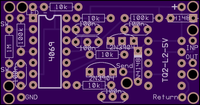
OSH Park
Shared projects
Andy Relay TQ2-L2-5V
by
2
layer board of
1.80x0.94
inches
(45.67x23.95
mm).
Shared on
March 14th, 2015 02:49.
JB Project
by
2
layer board of
1.52x2.42
inches
(38.51x61.39
mm).
Shared on
March 13th, 2015 23:19.
Jon Brito 296 Board
I2C FET driver
by
2
layer board of
0.71x1.32
inches
(18.06x33.40
mm).
Shared on
March 13th, 2015 22:54.
Based on the SFE mini-FET driver, an I2C IO expander with 8 FET driven outputs that can sink high currents
9-Led Flashlight "Cheapies" R-board add-on
by
2
layer board of
1.70x0.80
inches
(43.18x20.32
mm).
Shared on
March 13th, 2015 22:40.
$6.80 gives you R-boards enough for 6 flashlights, so why not share them?
If this design is too small, try my newer version.
A high-tech twist for the cheap 9LED flashlights - cut off one of these round boards and surface-mount 2 15ohm resistors in the slots, remove the stock 3xAAA holder from the flashlight (use it elsewhere, like for an arduino or something) and use a Lithium-Ion 18500 cell instead! Then add this populated R-board between the back end (-) of the battery/cell and the switch/tailcap spring.
The only other part to add is some craft foam to wrap around the cell for cushioning, approximately 1/16 - 3/32 inch thick. Done!
The resistance added on this board prevents the Li-Ion cell from frying the LEDs with too much current, and 15ohm/2 (=7.5) conveniently approximates 20mA for each of the LEDs (total ~175mA max at full charge) so they’ll last nearly forever without burning out…but given the cheap construction of these flashlights, you may still need to remove the LED board somewhere down the road to mend/improve the edge-mount solder connections if it starts to flicker.
Be sure to get Li-Ions with protection boards built in, as you probably don’t want a fire in your pocket should anything happen to go wrong. I got protected cells and have had no trouble at all.
Assembly: 1 x 15ohm 1/4W resistor in each slot with leads bent to opposite sides of the board, ignoring the thru-holes for them. Solder down to exposed traces, building a center spiral on one side (to contact the back (-) of the cell), and keeping the center clear on the other side for the tailcap spring. Tin the center of the pad where the spring rests, though.
Bugs:
* The break-apart didn’t work - the cut-outs did not come through for me and it’s one solid board.
* Aside from the cut-outs not working out (and I discovered an explanation why), nothing to go wrong, except in assembly.
* I’ll update with images.
* Solder mask not laid out for the “center spiral” idea (front/back sides not differentiated), some scraping may be needed. YMMV.
* This design, at ~0.75", was too small to seat solidly in my flashlight and while it works, it also will slide around when the tailcap is removed. The fixed version for this cutout-fail is also increased to about 0.9" diameter to make a much tighter fit, but will need edge smoothing and rounding once broken apart.
Just another GPS Logger
by
2
layer board of
2.36x1.46
inches
(60.02x37.01
mm).
Shared on
March 13th, 2015 18:42.
Two pads on the bottom used to connect with a QI wireless receiver. Otherwise use a LiPo battery.









